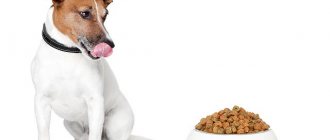Dogs have become members of our families. They protect and live with people, follow commands and understand without words, but remain animals. Therefore, dishes from the dinner table should not end up in your pet’s bowl.
It's not just about their upbringing. Some foods consumed by humans are dangerous for dogs. Among them is chocolate. Unfortunately, not all pet owners still know about this, and can harm their pet.
Is it dangerous to give it?
Dogs are known to their owners for their willingness to eat something tasty at any time of the day or night. For example, they like the smell and taste of chocolate, but should never be given it.
It’s not so much the delicacy that is dangerous, but the substance in it – theobromine. It is a plant alkaloid found in cocoa beans and imparts a bitter taste. Being an analogue of caffeine, it acts on the cardiovascular system and has a psychostimulating effect.
The human body easily eliminates theobromine, unlike animals. The substance is not digested in the dog's body. Remaining in the blood for up to 20 hours, it disrupts the functioning of the cardiovascular, nervous and digestive systems.
Symptoms of poisoning
You can notice changes in the animal’s condition after three to four hours. Due to the release of adrenaline, the dog becomes hyperactive. In this state, she looks for places to hide and cannot calm down.
The animal's breathing and heart rate increase, and its temperature rises. Theobromine has a diuretic effect, so the animal asks to go outside. Severe thirst, vomiting and diarrhea begin.
Treatment and consequences
If left untreated, the dog will bleed from the inside, convulse, and may even suffer a heart attack. Without veterinary care, coma and death occur within 36 hours.
Therefore, it is important to go to a hospital as soon as possible. If this is not possible, be sure to rinse the dog’s stomach and give adsorbents. Do not try to stop vomiting with medications; on the contrary, make sure that everything you previously eaten comes out, including the toxin in the chocolate.
Dogs with epilepsy are at particular risk. They may have an epileptic seizure.
My dog ate chocolate and felt great, so what's the matter?
Everyone has heard that chocolate is dog poison, but many dogs who eat a little of this treat do not experience any pain. The fact is that poison is always a dose.
Theobromine and caffeine.
If you ask dog owners what foods should not be fed to these four-legged dogs, they will list foods such as onions, garlic, rhubarb, grapes and chocolate. (By the way, if porridge is on their list, don’t listen to them). Dogs' inability to safely consume chocolate is well known, but because they tend to eat everything indiscriminately, many of them have to be treated every year for chocolate ingestion.
However, there are dogs, and there are also very, very many of them, who eat chocolate (with or without the knowledge of their owners) and at the same time feel great, without needing treatment at all. If chocolate is extremely harmful to dogs, then why are these four-legged sweet tooths doing so well?
Because poison is always a dose.
The components of chocolate that are toxic to dogs are theobromine and caffeine. These chemicals are structurally almost identical, and both are classified as methylxanthines.
One of the factors that makes methylxanthines extremely dangerous for animals is their extremely slow absorption. This is especially true for theobromine. In dogs, caffeine levels in plasma (the noncellular component of blood) peak at 30 to 60 minutes, with a plasma half-life of 4.5 hours. But the situation with theobromine is worse: its concentration in dog plasma reaches its peak no earlier than after 10 hours, its half-life is 17.5 hours.
When in the blood, methylxanthines produce a number of effects. First of all, they inhibit the activation of adenosine receptors. These receptors are mainly responsible for putting the body into a sleepy state and reducing its activity. Methylxanthines suppress drowsiness by acting as stimulants.
● Click here to learn how grapefruit affects theobromine metabolism ●
The enzyme responsible for theobromine metabolism is a member of the P450 family of enzymes. If you have heard about these enzymes, it is most likely because the absorption of many medications depends on them, and you are taking one of them (for example, Viagra, Cialis, erythromycin, Xanax) and you have been advised not to drink grapefruit juice. The recommendation is explained by the fact that the chemical compounds contained in grapefruit affect P450 enzymes, without the normal functioning of which the absorption of drugs is difficult and an overdose can occur. In addition to grapefruit, such compounds are found in pomelo, bitter and Seville oranges used to make marmalade. Fortunately, dogs rarely eat fruits containing these compounds, but if a dog like the famous Marmaduke eats a decent portion of marmalade, and even a little chocolate, he will be in serious trouble.
So what happens if your dog eats a chocolate bar? She will feel nauseous and possibly vomit, her heart will race, she will have diarrhea, she will show signs of hyperactivity and, if the dose of methylxanthines is too high, she may experience tremors, seizures and even death.
What dose of methylxanthines should be considered high depends on the type of dog you have.
According to the ASPCA (American Humane Society), signs of mild theobromine poisoning are observed at a dose of 20 mg/kg, and severe ones starting at 40 mg/kg. Already at a dose of 60 mg/kg, convulsions may begin. In toxicology studies, measuring the toxicity of a substance is usually determined by its median lethal dose (LD50), that is, the dose required to kill half of a sample population. For theobromine, the LD50 is 100–200 mg/kg.
Please note: all doses are calculated per kilogram of dog weight, so a dose of theobromine that is low for a German Shepherd may be extremely high for a Chihuahua.
To illustrate this, let's take three dogs. Let's start with Baci, a five-year-old, seven-kilogram female maltipoo. By all criteria, this is a small dog.
Baci
Next up is Chanelle, a ten-year-old female golden retriever, medium size, 25 kg.
Chanelle
And finally, Jupiter, a five-year-old male, a cross between a Malamute and a German Shepherd. This is a large dog weighing 50 kg.
Jupiter
I calculated what would happen to each of these dogs after they ate the same amount of chocolate. The results I obtained can be seen in the table below. These numbers can easily be checked using some online chocolate toxicity calculator.
| Theobromine dosage Bachi | Theobromine dosage Chanel | Dose of theobromine Jupiter | |
| Milk chocolate (1 large bar, 85 g) | 22 mg/kg | 6.3 mg/kg | 3.2 mg/kg |
| Dark chocolate (1 large bar, 85 g) | 54 mg/kg | 15 mg/kg | 7.5 mg/kg |
| Cocoa powder (1/3 cup, 30 g) | 87 mg/kg | 24 mg/kg | 12 mg/kg |
| Culinary (confectionery) chocolate (bitter, 1 large bar, 85 g) | 158 mg/kg | 44 mg/kg | 22 mg/kg |
| (Green 60 mg/kg) | |||
So we see that after eating 1/3 cup (US cup is 240 ml) of cocoa powder (the amount common in chocolate brownie recipes), Jupiter would probably be fine, Chanel would probably get sick, and Bachi can have such convulsions that often lead to death.
It is easy to see, if you are willing to think about the table numbers, that a great many dogs will remain perfectly fine after eating foods containing chocolate. Chanel can easily eat half a cup of chocolate ice cream, a cup of chocolate pudding or a chocolate cupcake - and at least he won't give a damn!
| Number of tested types (brands) | Average theobromine content (mg/g) | Average caffeine content (mg/g) | Average theobromine content (mg/1 serving) | Average caffeine content (mg/1 serving) | |
| Cocoa | |||||
| Cocoa | 1 | 20,3 | 3,14 | ||
| Culinary (confectionery) chocolate | |||||
| Bitter culinary chocolate without sugar | 2 | 13,0 | 1,55 | ||
| Dark cooking chocolate | 3 | 5,65 | 0,617 | ||
| Milk chocolate chips | 2 | 1,50 | 0,261 | ||
| Chocolate bars, bars and candies | |||||
| Dark chocolate | 2 | 4,41 | 0,540 | ||
| Chocolate breakfast bars | 1 | 1,36 | 0,116 | 52,8 | 4,4 |
| Milk chocolate | 6 | 1,88 | 0,194 | ||
| Fudge (chocolate toffee) | 1 | 6,55 | 0,646 | 41,3 | 4,1 |
| Sweet toppings | |||||
| Chocolate syrup, 2 tbsp. spoons | 1 | 2,12 | 0,272 | 76,8 | 9,8 |
| Chocolate fudge topping, 2 tbsp. spoons | 2 | 1,58 | 0,088 | 62,7 | 3,5 |
| Frosting (butter coating) of chocolate fudge | 3 | 2,13 | 0,123 | 75.3a | 4.2a |
| Bakery | |||||
| Brownie | 6 | 1,42 | 0,138 | 29,4 | 2,8 |
| Chocolate Chip Cookies | 3 | 17,6 | 2,1 | ||
| Chocolate cupcakes | 3 | 1,50 | 0,176 | 33,7 | 3,8 |
| Chocolate cake without frosting, 1/12 of a cake | 8 | 1,62 | 0,155 | 73,3 | 7,3 |
| Chocolate cake with chocolate frosting, 1/12 of a cake | 6 | 161,2 | 15,8 | ||
| Chocolate bar with nuts | 2 | 1,14 | 0,152 | 54,2 | 7,3 |
| Diabetic chocolate chip cookies | 1 | 1,23 | 0,085 | 12,1 | 0,8 |
| Flakes | |||||
| Rice and corn flakes with cocoa | 3 | 0,70 | 0,071 | ||
| Puddings | |||||
| Children's pudding with chocolate custard | 1 | 0,22 | 0,008 | 28,5 | 1,1 |
| Chocolate pudding and pie filling powder | 2 | 2,28 | 0,226 | 62,2 | 6,1 |
| Ready-to-eat chocolate pudding | 2 | 0,62 | 0,049 | 87,5 | 7,0 |
| Beverages and dairy products | |||||
| Cocoa drinks, powder | 12 | 2,66 | 0,208 | 65.5b | 5.3b |
| Chocolate milk | 3 | 0,23 | 0,011 | 58,7 | 2,8 |
| Chocolate ice cream, half a cup | 3 | 0,62 | 0,032 | 43,5 | 2,2 |
● How about cocoa bean husk mulch? (click) ●
In recent years, mulch made from cocoa bean husks has gained popularity. This mulch is considered an excellent substitute for traditional mulch. It adds nutrients to the soil and prevents weed growth, so it can greatly benefit your garden. But with all this, it is very dangerous for your dog. Because cocoa bean husk mulch contains up to 32 mg of theobromine per gram, it may be a more potent source of theobromine than even pure, unsweetened cooking chocolate. If you are not sure that your dog will not chew such mulch, it is better to use traditional one, since it will cost you much less!
Even if your dog eats a little chocolate and does not experience any pain, it is still better not to give him this treat. One study found that repeated exposure of dogs to theobromine led to the development of cardiomyopathy (a chronic disease of the heart muscle that impairs blood circulation).
● Among other things, a dog's ability to metabolize theobromine can be influenced by genotype (click to read) ●
Dogs with one of the CYP1A2 gene variants (variant 1117C>T) are unable to properly metabolize and break down certain substances, including lidocaine, naproxen, and theobromine. Apparently, this is where the answer to the question of why some dogs get sick from a tiny piece of chocolate lies. This circumstance is important to consider when treating a dog in a veterinary clinic.
So, what should you do if you suspect that your dog has eaten chocolate? There are several options. You can use an online calculator (like this one) to determine if your dog is sick or call your veterinarian. Remember that a calculator test is not a substitute for a veterinary examination, so regardless of the results, you should monitor your dog closely for signs such as heart palpitations, vomiting or tremors.
If your dog has eaten chocolate, and you don’t know how much, if she has symptoms of poisoning, if she is pregnant (theobromine can enter the fetus through the placenta) or something else has weakened her health, you should immediately contact a veterinarian. Poisoning may not appear immediately, but only two hours after the dog has swallowed the chocolate, but the sooner veterinary treatment is carried out, the better.
What do veterinarians do to treat a dog poisoned by theobromine? They cleanse her stomach. First of all, if the poisoning has occurred recently, all contents are removed from it. This is often done with apomorphine administered through the eye for rapid absorption.
Then activated carbon is used, a powder that can bind many chemicals. Activated charcoal is most effective when given immediately after poisoning. For dogs, it is usually mixed with wet food (be warned: your dog's poop will turn black). In some cases it is necessary to give coal repeatedly, in others - once is enough.
In addition, a dog with theobromine poisoning is treated with drugs that relieve specific symptoms, such as diazepam (for seizures and overexcitement), beta blockers, and atropine (for high and low heart rates, respectively).
Finally: something about cats
Oddly enough, theobromine is more dangerous for cats than for dogs. However, we have not heard of cats getting sick after eating chocolate. Why?
The main reason is that cats tend to be picky eaters. Dogs, on the other hand, are notoriously indiscriminate: they will eat almost anything edible that comes under their nose (including the butts of cannabis joints, which can cause drug poisoning). Cats' pickiness is partly due to the fact that they are indifferent to glucose.
You, too, most likely would not eat chocolate if it were always completely unsweetened.
So, it's worth remembering the following:
- Chocolate is dangerous for dogs mainly due to the theobromine it contains, which cannot be effectively metabolized by the dog's body.
- The amount of chocolate that can be given to a dog without fear of it exhibiting symptoms of poisoning depends significantly on its weight.
- If your dog eats chocolate, you should monitor him closely and contact your veterinarian if you notice symptoms of poisoning, or if he is very young, pregnant, or has any other health problems.
Special thanks to Rachel Malkani, MSc, Certified Canine Consultant, PhD, and Henry, who, as you might have guessed, loves to eat chocolate, prompting me to write this article.
You might be interested in:
Dogs are smarter than cats: Dogs (and raccoons) have the highest number of neurons among carnivores.
Notes
a One serving is equal to one twelfth of the given mixture - enough to make 1/12 of the cake. b One serving, according to package directions, is 6 ounces (170 g) for hot drinks and 8 (226.8 g) for cold drinks.
How many kills?
A small amount of sweets will not cause serious problems for your dog. The maximum that can await you is an upset stomach, vomiting or diarrhea. Therefore, if your pet begs you for one piece of candy or a square of chocolate bar, do not worry and call the veterinarian. Of course, we are not talking about regular treats.
With larger amounts of chocolate eaten, dogs become severely intoxicated. The risk of poisoning is real when consuming 15-80 milligrams of theobromine per 1 kilogram of body weight.
100-150 milligrams per 1 kilogram of weight is a rather dangerous dosage. 7 grams of dark chocolate contains this amount of toxic substance. For comparison, a tile usually weighs 90 or 100 grams.
The lethal dose is 300 milligrams of theobromine per 1 kilogram of weight.
Pregnant, lactating and puppies
Since the effect of the substance depends on the weight of the animal, young animals are most susceptible to poisoning. Curiosity leads kids to the most secluded corners of the house, including those where something edible is left. Although in the history of dog breeders there have been cases where puppies ate chocolate and subsequently recovered, all they had to do was wash their stomach.
According to dog owners , in some cases chocolate and other sweets are even beneficial. Sugar is a source of quickly digestible carbohydrates. Therefore, it is recommended to give it to dogs during childbirth. In the intervals between the birth of puppies, mothers can drink sweet water and eat a few pieces of milk or white chocolate.
White, milky and dark
Types of chocolate differ in the content of cocoa beans, which contain theobromine. Therefore, bakery and dark chocolate are the most dangerous for dogs. One hundred grams contains 1410 milligrams of theobromine.
Dairy varieties have less cocoa, which means they are less dangerous at the same dosages. One hundred grams of milk chocolate contains 159 milligrams of theobromine. White chocolate contains no cocoa beans, only cocoa butter. Therefore, it is safe for dogs, unless you take into account the large amount of sugar.
An animal weighing 10 kilograms will most likely die from intoxication after eating 60 grams of dark chocolate. The lethal dose of milk chocolate is 200 grams.
A dog weighing 20 kilograms will die after 400 grams of dark chocolate and 2.8 kg of milk chocolate.
Symptoms of sweet poisoning in an animal
Using sweets in your pet's diet can cause severe poisoning, not death. But this, too, will not lead to any good consequences, except for weakening of health. Among the most striking symptoms of sweet poisoning in dogs:
- Diarrhea, vomiting and nausea.
- Excess energy and hyperactivity.
- Unmotivated aggression, refusal to obey the owner’s commands.
- Frequent urination.
- Increased body temperature.
- Convulsions and tremors of the limbs.
- Swelling of the abdominal cavity.
If the poisoning is acute, the animal may die on the second day. This raises the question: “How to treat dog poisoning with chocolate?” Gastric lavage and symptomatic treatment can cope with it. Additional treatment may be needed if your four-legged friend has eaten a piece of foil along with food. The metal can have a toxic effect on the pet's gastrointestinal tract if it is not removed from the acidic environment in time.
Expert opinion
Kuzmenko Olga Olegovna
Information about the expert
Ask a Question
All measures must be taken by a veterinarian, otherwise treatment may not be effective. Contact him at the first symptoms.
Are other products harmful?
Theobromine, which is found in cocoa, does not lose its properties in confectionery products such as baked goods, chocolate ice cream, and cookies. But its concentration there is much less.
However, don't rush to cool your dog down with a cupcake or the contents of a waffle cone. Dogs do not metabolize glucose well. Frequent consumption of sugar affects the functioning of the pancreas, the condition of the skin, coat and teeth. The eyes and ears may also fester, and subsequently allergies and diabetes may develop.
Baking uses preservatives and dyes that are definitely not beneficial. Ice cream can cause diarrhea, as dogs are lactose intolerant.
Despite all the prohibitions, the choice of treats for dogs remains. Give your dog fruits, berries and nuts. For encouragement during training and games, it is better to purchase special chocolate for dogs in pet stores. It contains everything that is in the regular one, except for toxic substances.
So, there is all the evidence that chocolate is dangerous to the health and life of dogs. At a low dosage, sweetness will not affect the four-legged condition in any way, but chocolate cannot be given constantly. It contains sugar and preservatives that are not absorbed by the pet's body.
What can your pet eat instead of chocolate?
We have already found out that chocolate is poisonous to pets. But if the dog loves sweets and asks for regular chocolate, then it can be replaced. To maintain the health of your four-legged pet, veterinarians advise adding the following products to a complete diet:
- Instead of giving a small piece of a sweet bar, it is better to treat him with fruit. You can use fresh apples, bananas, raspberries, and blackberries. It is better not to overuse dried fruits, as they contain sucrose. But if the dog asks, then you can feed it in small quantities. Grapes and raisins should not be consumed by animals, as they negatively affect the health of vital organs.
- A teaspoon of natural honey is the best sweet substitute. But do not forget that everything should be in moderation.
- Your four-legged friend can occasionally enjoy seeds and nuts. Frequent consumption of these products will lead to obesity.
I hope we answered your question: “Can a dog eat chocolate?” If your pet has a sweet tooth, it’s easy to find a replacement. Even a small amount of chocolate will harm your pet's health, so don't take the risk.











